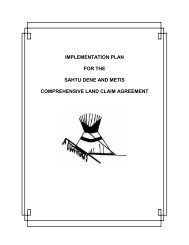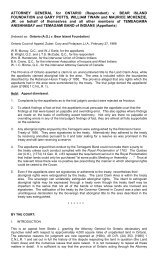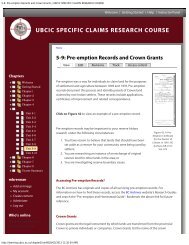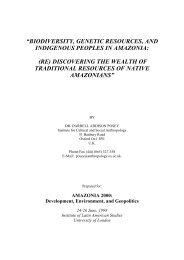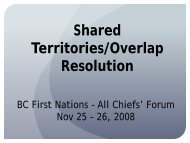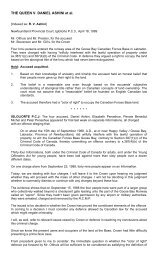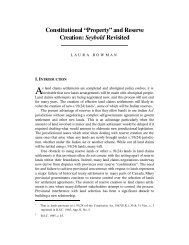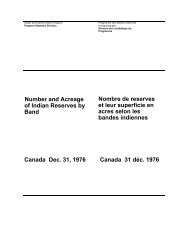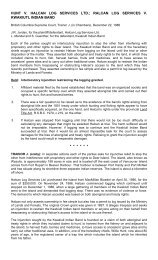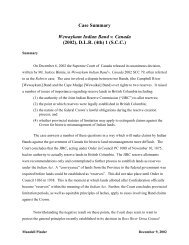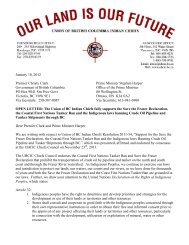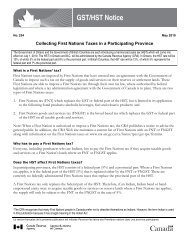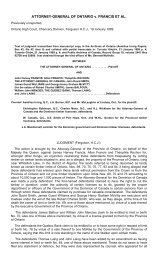ST. CATHERINE'S MILLING AND LUMBER COMPANY (1)The ...
ST. CATHERINE'S MILLING AND LUMBER COMPANY (1)The ...
ST. CATHERINE'S MILLING AND LUMBER COMPANY (1)The ...
You also want an ePaper? Increase the reach of your titles
YUMPU automatically turns print PDFs into web optimized ePapers that Google loves.
195..With regard to the application of the British North American Act and the construction to beplaced upon it, it was submitted that that Act should be on all occasions interpreted in a large,liberal, and comprehensive spirit, considering the magnitude of the subjects with which it purportsto deal in very few words. <strong>The</strong> general scheme, purpose, and intent of the Act should be borne inmind. <strong>The</strong> scheme is to create a federal union consisting of several entities. <strong>The</strong> purpose was atthe same time to preserve the Provinces, not as fractions of a unit, but as units of a multiple. <strong>The</strong>Provinces are to be on an equal footing. <strong>The</strong> ownership and development of Crown lands and therevenues therefrom are to be left to the Province in which they are situated. As to legislativepowers, it is the residuum which is left to the Dominion; as to proprietary rights, the residuum goesto the Provinces. Where property is intended to go to the Dominion it is specifically granted, eventhough legislative authority over it may already have been vested in the Dominion. It is contrary tothe spirit of the Act to hold that the grant of legislative power over lands reserved for the Indianscarries with it by implication a grant of proprietary right.Sir R. E. Webster, A.G., replied:--Upon the question whether the old province of Canada had any right to the lands in suit at thedate of the Act of 1867 which passed thereunder, certain legislative duties had been conferred onthe province with regard to Indians, and a certain power of bargaining with regard to Indian lands;but no proprietary right had been given: see 2 vict. c. 15 (U.C.), which was held to apply tounsurrendered lands in <strong>The</strong> Queen v. Strong (1) Upp. Can. Rep. 1 Ch. 392., and Little v. Keating (2) 6Upp. Can. Rep. Q.B. (O.S.) 265.. <strong>The</strong>re is a series of statutes which shews that prior to 1867 theProvince had nothing but some slight legislative rights over the land: see 3 & 4 Vict. c. 35, s. 54;12 Vict. c. 9; 13 & 14 Vict. c. 74; Cons. Stat. 22 Vict. (U.C.) c. 81; 23 Vict. c. 61, s. 54. <strong>The</strong> wholecourse of legislation before 1867 was that the proceeds of the Indian lands should be kept for theIndians, and not go to the Province. [LORD SELBORNE:--This is the first suggestion to thateffect.] Reference was then made to the later Dominion Acts, 31 Vict. c. 42, ss. 6, 7, 8, 10, 11,especially 25; 39 Vict. c. 18; 43 Vict. c. 28. <strong>The</strong> Crown lands were dealt with by 23 Vict. c. 2; theIndian lands by 23 Vict. c. 151. Reference was made to Vanvleck v. Stewart (3) 19 Upp. Can. Rep.Q.B. 489.; Fegan v. McLean (4) 29 Upp. Can. Rep. Q.B. 202., as shewing that the Indians had the right tocut and sell timber in the special reserves, and appropriate the proceeds.<strong>The</strong> judgment of their Lordships was delivered byLORD WATSON:--On the 3rd of October, 1873, a formal treaty or contract was concluded between commissionersappointed by the Government of the Dominion of Canada, on behalf of Her Majesty the Queen, ofthe one part, and a number of chiefs and headmen duly chosen to represent the Salteaux tribe ofOjibewa Indians, of the other part, by which the latter, for certain considerations, released andsurrendered to the Government of the Dominion, for Her Majesty and her successors, the wholeright and title of the Indian inhabitants whom they represented, to a tract of country upwards of50,000 square miles in extent. By an article of the treaty it is stipulated that, subject to suchregulations as may be made by the Dominion Government, the Indians are to have right to pursuetheir avocations of hunting and fishing throughout the surrendered territory, with the exception ofthose portions of it which may, from time to time, be required or taken up for settlement, mining,lumbering, or other purposes.Of the territory thus ceded to the Crown, an area of not less than 32,000 square miles issituated within the boundaries of the Province of Ontario; and, with respect to that area, acontroversy has arisen between the Dominion and Ontario, each of them maintaining that the legaleffect of extinguishing the Indian title has been to transmit to itself the entire beneficial interest ofthe lands, as now vested in the Crown, freed from encumbrance of any kind, save the qualifiedprivilege of hunting and fishing mentioned in the treaty.Acting on the assumption that the beneficial interest in these lands had passed to the DominionGovernment, their Crown Timber Agent, on the 1st of May, 1883, issued to the appellants, the St.Catherine's Milling and Lumber Company, a permit to cut and carry away one million feet oflumber from a specified portion of the disputed area. <strong>The</strong> appellants having availed themselves ofthat licence, a writ was filed against them in the Chancery Division of the High Court of Ontario, atthe instance of the Queen on the information of the Attorney-General of the Province, praying--(1)a declaration that the appellants have no rights in respect of the timber cut by them upon the landsspecified in their permit; (2) an injunction restraining them from trespassing on the premises andfrom cutting any timber thereon; (3) an injunction against the removal of timber already cut; and (4)
decree for the damage occasioned by their wrongful acts. <strong>The</strong> Chancellor of Ontario, on the 10thof June, 1885, decerned with costs against the appellants, in terms of the first three of theseconclusions, and referred the amount of damage to the Master in Ordinary. <strong>The</strong> judgment of thelearned Chancellor was unanimously affirmed on the 20th of April, 1886, by the Court of Appealfor Ontario, and an appeal taken from their decision to the Supreme Court of Canada wasdismissed on the 20th of June, 1887, by a majority of four of the six judges constituting the court.Although the present case relates exclusively to the right of the Government of Canada todispose of the timber in question to the appellant company, yet its decision necessarily involvesthe determination of the larger question between that government and the province of Ontario withrespect to the legal consequences of the treaty of 1873. In these circumstances, Her Majesty, bythe same order which gave the appellants leave to bring the judgment of the Court below underthe review of this Board, was pleased to direct that the Government of the Dominion of Canadashould be at liberty to intervene in this appeal, or to argue the same upon a special case raisingthe legal question in dispute. <strong>The</strong> Dominion Government elected to take the first of these courses,and their Lordships have had the advantage of hearing from their counsel an able and exhaustiveargument in support of their claim to that part of the ceded territory which lies within the provincialboundaries of Ontario.<strong>The</strong> capture of Quebec in 1759, and the capitulation of Montreal in 1760, were followed in 1763by the cession to Great Britain of Canada and all its dependencies, with the sovereignty, property,and possession, and all other rights which had at any previous time been held or acquired by theCrown of France. A royal proclamation was issued on the 7th of October, 1763, shortly after thedate of the Treaty of Paris, by which His Majesty King George erected four distinct and separateGovernments, styled respectively, Quebec, East Florida, West Florida, and Grenada, specificboundaries being assigned to each of them. Upon the narrative that it was just and reasonablethat the several nations and tribes of Indians who lived under British protection should not bemolested or disturbed in the "possession of such parts of Our dominions and territories as, nothaving been ceded to or purchased by us, are reserved to them or any of them as their huntinggrounds," it is declared that no governor or commander-in-chief in any of the new colonies ofQuebec, East Florida, or West Florida, do presume on any pretence to grant warrants of survey orpass any patents for lands beyond the bounds of their respective governments, or "until Ourfurther pleasure be known," upon any lands whatever which, not having been ceded or purchasedas aforesaid, are reserved to the said Indians or any of them. It was further declared "to be OurRoyal will, for the present, as aforesaid, to reserve under Our sovereignty, protection, anddominion, for the use of the said Indians, all the land and territories not included within the limits ofOur said three new Governments, or within the limits of the territory granted to the Hudson's BayCompany." <strong>The</strong> proclamation also enacts that no private person shall make any purchase from theIndians of lands reserved to them within those colonies where settlement was permitted, and thatall purchases must be on behalf of the Crown, in a public assembly of the Indians, by the governoror commander-in-chief of the colony in which the lands lie.<strong>The</strong> territory in dispute has been in Indian occupation from the date of the proclamation until1873. During that interval of time Indian affairs have been administered successively by theCrown, by the Provincial Governments, and (since the passing of the British North America Act,1867), by the Government of the Dominion. <strong>The</strong> policy of these administrations has been all alongthe same in this respect, that the Indian inhabitants have been precluded from entering into anytransaction with a subject for the sale or transfer of their interest in the land, and have only beenpermitted to surrender their rights to the Crown by a formal contract, duly ratified in a meeting oftheir chiefs or head men convened for the purpose. Whilst there have been changes in theadministrative authority, there has been no change since the year 1763 in the character of theinterest which its Indian inhabitants had in the lands surrendered by the treaty. <strong>The</strong>ir possession,such as it was, can only be ascribed to the general provisions made by the royal proclamation infavour of all Indian tribes then living under the sovereignty and protection of the British Crown. Itwas suggested in the course of the argument for the Dominion, that inasmuch as the proclamationrecites that the territories thereby reserved for Indians had never "been ceded to or purchased by"the Crown, the entire property of the land remained with them. That inference is, however, atvariance with the terms of the instrument, which shew that the tenure of the Indians was apersonal and usufructuary right, dependent upon the good will of the Sovereign. <strong>The</strong> landsreserved are expressly stated to be "parts of Our dominions and territories;" and it is declared tobe the will and pleasure of the sovereign that, "for the present," they shall be reserved for the useof the Indians, as their hunting grounds, under his protection and dominion. <strong>The</strong>re was a greatdeal of learned discussion at the Bar with respect to the precise quality of the Indian right, but theirLordships do not consider it necessary to express any opinion upon the point. It appears to themto be sufficient for the purposes of this case that there has been all along vested in the Crown asubstantial and paramount estate, underlying the Indian title, which became a plenum dominium
whenever that title was surrendered or otherwise extinguished.By an Imperial statute passed in the year 1840 (3 & 4 Vict. c. 35), the provinces of Ontario andQuebec, then known as Upper and Lower Canada, were united under the name of the Province ofCanada, and it was, inter alia, enacted that, in consideration of certain annual payments which HerMajesty had agreed to accept by way of civil list, the produce of all territorial and other revenues atthe disposal of the Crown arising in either of the united Provinces should be paid into theconsolidated fund of the new Province. <strong>The</strong>re was no transfer to the Province of any legal estate inthe Crown lands, which continued to be vested in the Sovereign; but all moneys realized by salesor in any other manner became the property of the Province. In other words, all beneficial interestin such lands within the provincial boundaries belonging to the Queen, and either producing orcapable of producing revenue, passed to the Province, the title still remaining in the Crown. Thatcontinued to be the right of the Province until the passing of the British North America Act, 1867.Had the Indian inhabitants of the area in question released their interest in it to the Crown at anytime between 1840 and the date of that Act, it does not seem to admit of doubt, and it was notdisputed by the learned counsel for the Dominion, that all revenues derived from its being takenup for settlement, mining, lumbering, and other purposes would have been the property of theProvince of Canada. <strong>The</strong> case maintained for the appellants is that the Act of 1867 transferred tothe Dominion all interest in Indian lands which previously belonged to the Province.<strong>The</strong> Act of 1867, which created the Federal Government, repealed the Act of 1840, and restoredthe Upper and Lower Canadas to the condition of separate Provinces, under the titles of Ontarioand Quebec, due provision being made (sect. 142) for the division between them of the propertyand assets of the United Province, with the exception of certain items specified in the fourthschedule, which are still held by them jointly. <strong>The</strong> Act also contains careful provisions for thedistribution of legislative powers and of revenues and assets between the respective Provincesincluded in the Union, on the one hand, and the Dominion, on the other. <strong>The</strong> conflicting claims tothe ceded territory maintained by the Dominion and the Province of Ontario are wholly dependentupon these statutory provisions. In construing these enactments, it must always be kept in viewthat, wherever public land with its incidents is described as "the property of" or as "belonging to"the Dominion or a Province, these expressions merely import that the right to its beneficial use, orto its proceeds, has been appropriated to the Dominion or the Province, as the case may be, andis subject to the control of its legislature, the land itself being vested in the Crown.Sect. 108 enacts that the public works and undertakings enumerated in Schedule 3 shall be theproperty of Canada. As specified in the schedule, these consist of public undertakings which mightbe fairly considered to exist for the benefit of all the Provinces federally united, of lands andbuildings necessary for carrying on the customs or postal service of the Dominion, or required forthe purpose of national defence, and of "lands set apart for general public purposes." It is obviousthat the enumeration cannot be reasonably held to include Crown lands which are reserved forIndian use. <strong>The</strong> only other clause in the Act by which a share of what previously constitutedprovincial revenues and assets is directly assigned to the Dominion is sect. 102. It enacts that all"duties and revenues" over which the respective legislatures of the United Provinces had andhave power of appropriation, "except such portions thereof as are by this Act reserved to therespective legislatures of the Provinces, or are raised by them in accordance with the specialpowers conferred upon them by this Act," shall form one consolidated fund, to be appropriated forthe public service of Canada. <strong>The</strong> extent to which duties and revenues arising within the limits ofOntario, and over which the legislature of the old Province of Canada possessed the power ofappropriation before the passing of the Act, have been transferred to the Dominion by this clause,can only be ascertained by reference to the two exceptions which it makes in favour of the newprovincial legislatures.<strong>The</strong> second of these exceptions has really no bearing on the present case, because itcomprises nothing beyond the revenues which provincial legislatures are empowered to raise bymeans of direct taxation for Provincial purposes, in terms of sect. 92 (2). <strong>The</strong> first of them, whichappears to comprehend the whole sources of revenue reserved to the provinces by sect. 109, is ofmaterial consequence. Sect. 109 provides that "all lands, mines, minerals, and royalties belongingto the several Provinces of Canada, Nova Scotia, and New Brunswick, at the union, and all sumsthen due or payable for such lands, mines, minerals, or royalties, shall belong to the severalProvinces of Ontario, Quebec, Nova Scotia, and New Brunswick, in which the same are situate orarise, subject to any trusts existing in respect thereof, and to any interest other than that of theProvince in the same." In connection with this clause it may be observed that, by sect. 117, it isdeclared that the Provinces shall retain their respective public property not otherwise disposed ofin the Act, subject to the right of Canada to assume any lands or public property required forfortifications or for the defence of the country. A different form of expression is used to define thesubject-matter of the first exception, and the property which is directly appropriated to the
Provinces; but it hardly admits of doubt that the interests in land, mines, minerals, and royalties,which by sect. 109 are declared to belong to the Provinces, include, if they are not identical with,the "duties and revenues" first excepted in sect. 102.<strong>The</strong> enactments of sect. 109 are, in the opinion of their Lordships, sufficient to give to eachProvince, subject to the administration and control of its own Legislature, the entire beneficialinterest of the Crown in all lands within its boundaries, which at the time of the union were vestedin the Crown, with the exception of such lands as the Dominion acquired right to under sect. 108,or might assume for the purposes specified in sect. 117. Its legal effect is to exclude from the"duties and revenues" appropriated to the Dominion, all the ordinary territorial revenues of theCrown arising within the Provinces. That construction of the statute was accepted by this Board indeciding Attorney- General of Ontario v. Mercer (1) 8 App. Cas. 767., where the controversy related toland granted in fee simple to a subject before 1867, which became escheat to the Crown in theyear 1871. <strong>The</strong> Lord Chancellor (Earl Selborne) in delivering judgment in that case, said (2) 8 App.Cas. 776.: "It was not disputed, in the argument for the Dominion at the bar, that all territorialrevenues arising within each Province from 'lands' (in which term must be comprehended allestates in land), which at the time of the union belonged to the Crown, were reserved to therespective Provinces by sect. 109; and it was admitted that no distinction could, in that respect, bemade between lands then ungranted, and lands which had previously reverted to the Crown byescheat. But it was insisted that a line was drawn at the date of the union, and that the words werenot sufficient to reserve any lands afterwards escheated which at the time of the union were inprivate hands, and did not then belong to the Crown. <strong>The</strong>ir Lordships indicated an opinion to theeffect that the escheat would not, in the special circumstances of that case, have passed to theProvince as "lands;" but they held that it fell within the class of rights reserved to the Provinces as"royalties" by sect. 109.Had its Indian inhabitants been the owners in fee simple of the territory which they surrenderedby the treaty of 1873, Attorney-General of Ontario v. Mercer (1) 8 App. Cas. 767. might have been anauthority for holding that the Province of Ontario could derive no benefit from the cession, inrespect that the land was not vested in the Crown at the time of the union. But that was not thecharacter of the Indian interest. <strong>The</strong> Crown has all along had a present proprietary estate in theland, upon which the Indian title was a mere burden. <strong>The</strong> ceded territory was at the time of theunion, land vested in the Crown, subject to "an interest other than that of the Province in thesame," within the meaning of sect. 109; and must now belong to Ontario in terms of that clause,unless its rights have been taken away by some provision of the Act of 1867 other than thosealready noticed.In the course of the argument the claim of the Dominion to the ceded territory was rested uponthe provisions of sect. 91 (24), which in express terms confer upon the Parliament of Canadapower to make laws for "Indians, and lands reserved for the Indians." It was urged that theexclusive power of legislation and administration carried with it, by necessary implication, anypatrimonial interest which the Crown might have had in the reserved lands. In reply to thatreasoning, counsel for Ontario referred us to a series of provincial statutes prior in date to the Actof 1867, for the purpose of shewing that the expression "Indian reserves" was used in legislativelanguage to designate certain lands in which the Indians had, after the royal proclamation of 1763,acquired a special interest, by treaty or otherwise, and did not apply to land occupied by them invirtue of the proclamation. <strong>The</strong> argument might have deserved consideration if the expression hadbeen adopted by the British Parliament in 1867, but it does not occur in sect. 91 (24), and thewords actually used are, according to their natural meaning, sufficient to include all landsreserved, upon any terms or conditions, for Indian occupation. It appears to be the plain policy ofthe Act that, in order to ensure uniformity of administration, all such lands, and Indian affairsgenerally, shall be under the legislative control of one central authority.<strong>The</strong>ir Lordships are, however, unable to assent to the argument for the Dominion founded onsect. 92 (24). <strong>The</strong>re can be no à priori probability that the British Legislature, in a branch of thestatute which professes to deal only with the distribution of legislative power, intended to deprivethe Provinces of rights which are expressly given them in that branch of it which relates to thedistribution of revenues and assets. <strong>The</strong> fact that the power of legislating for Indians, and for landswhich are reserved to their use, has been entrusted to the Parliament of the Dominion is not in theleast degree inconsistent with the right of the Provinces to a beneficial interest in these lands,available to them as a source of revenue whenever the estate of the Crown is disencumbered ofthe Indian title.By the treaty of 1873 the Indian inhabitants ceded and released the territory in dispute, in orderthat it might be opened up for settlement, immigration, and such other purpose as to Her Majestymight seem fit, "to the Government of the Dominion of Canada," for the Queen and Her successors
for ever. It was argued that a cession in these terms was in effect a conveyance to the DominionGovernment of the whole rights of the Indians, with consent of the Crown. That is not the naturalimport of the language of the treaty, which purports to be from beginning to end a transactionbetween the Indians and the Crown; and the surrender is in substance made to the Crown. Even ifits language had been more favourable to the argument of the Dominion upon this point, it isabundantly clear that the commissioners who represented Her Majesty, whilst they had fullauthority to accept a surrender to the Crown, had neither authority nor power to take away fromOntario the interest which had been assigned to that province by the Imperial Statute of 1867.<strong>The</strong>se considerations appear to their Lordships to be sufficient for the disposal of this appeal.<strong>The</strong> treaty leaves the Indians no right whatever to the timber growing upon the lands which theygave up, which is now fully vested in the Crown, all revenues derivable from the sale of suchportions of it as are situate within the boundaries of Ontario being the property of that Province.<strong>The</strong> fact, that it still possesses exclusive power to regulate the Indians' privilege of hunting andfishing, cannot confer upon the Dominion power to dispose, by issuing permits or otherwise, ofthat beneficial interest in the timber which has now passed to Ontario. Seeing that the benefit ofthe surrender accrues to her, Ontario must, of course, relieve the Crown, and the Dominion, of allobligations involving the payment of money which were undertaken by Her Majesty, and which aresaid to have been in part fulfilled by the Dominion Government. <strong>The</strong>re may be other questionsbehind, with respect to the right to determine to what extent, and at what periods, the disputedterritory, over which the Indians still exercise their avocations of hunting and fishing, is to be takenup for settlement or other purposes, but none of these questions are raised for decision in thepresent suit.<strong>The</strong>ir Lordships will therefore humbly advise Her Majesty that the judgment of the SupremeCourt of Canada ought to be affirmed, and the appeal dismissed. It appears to them that thereought to be no costs of the appeal.Solicitors for appellants: Johnston, Harrison, & Powell.Solicitors for Attorney-General for Ontario: Freshfields & Williams.Solicitors for Attorney-General for the Dominion: Bompas, Bischoff, Dodgson, & Coxe.



